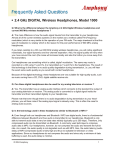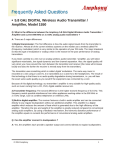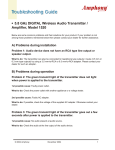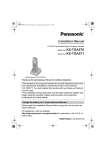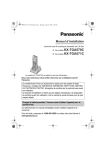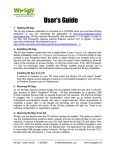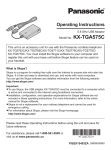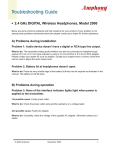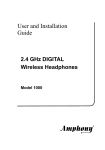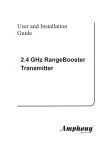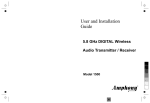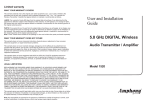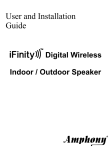Download 2.4 GHz DIGITAL Wireless Headphones, Model 2000
Transcript
R Frequently Asked Questions 2.4 GHz DIGITAL Wireless Headphones, Model 2000 Q: What is the difference between the Amphony 2.4 GHz Digital Wireless headphones and current 900 MHz wireless headphones ? A: The main difference is how the audio signal travels from the transmitter to your headphones. Almost all of the current wireless systems on the market use a method called FM (Frequency modulation) which is very similar to the operation of your FM radio. The major drawback ist that this type of modulation is ‘analog’ which is the reason for the poor performance of 900 MHz analog headphones. If you listen carefully to a CD over 900 MHz analog wireless headphones, you will notice significant noise/static, low signal dynamics and low channel separation. Also, the signal quality will vary when you move around the room (the noise will increase locally and also the further you move away from the transmitter). Our headphones use something which is called ‚digital' modulation. The same way music is recorded on a CD using 1's and 0's, it is transmitted as 1's and 0's to the headphones. The result of this technology is that there is no audio quality degradation during transmission, i.e. you will hear the exact same audio quality as you would with corded headphones. Because of this digital technology, these headphones are very suitable for high-quality audio, such as music coming from a CD, DVD, digital satellite receiver etc. Q: Can these digital headphones also be used for my analog television or receiver ? A: Yes. In addition to two digital audio interfaces, the transmitter also has an analog audio interface which connects to the standard line output of your analog television or receiver. The analog audio is converted to a digital signal inside the transmitter and then transmitted digitally to your headphones. Please note that even though there is no audio degradation during transmission to your headphones, you will hear noise if the analog input signal is already noisy. This is often the case for analog audio sources. Q: Is the technology used in these headphones similar to Bluetooth or MP3 ? A: Even though both our headphones and Bluetooth / MP3 use digital audio, there is a fundamental difference between Bluetooth and how audio is transmitted to our headphones. Bluetooth is only able to transmit audio data at very low data rates reliably (typically up to 200 kbps). Therefore, only compressed audio can be transmitted via Bluetooth. A commonly used technique to compress audio data is MP3. Our headphones, however, do not compress the audio and transmit the full bit rate. As a result, the audio quality is not degraded such as with MP3. Also, the audio latency (audio delay) of MP3 compressed audio is fairly high and thus not suitable for television or video applications. Since our headphones do not compress the audio and since only a minimum of data buffering is used, the audio delay is minimal. © 2004 Amphony 1 Q: How does the transmitter connect to my audio equipment ? A: The transmitter connects to any standard analog audio line output via the supplied stereo RCA audio cable and to coaxial and optical digital audio outputs. In cases where no analog line output (RCA audio out) is available, the transmitter can also connect to other audio outputs via appropriate adapters which are not supplied with the product. By using a Y adapter which has either a 3.5 mm or a 6.3 mm audio plug on one side and 2 RCA plugs on the other side, the transmitter can be connected to headphone outputs. Q: Can the transmitter connect to the digital audio output of my audio equipment ? A: Yes, in addition to the analog audio interface, the Model 2000 transmitter features a coaxial and an optical digital audio interface. By using one of these interfaces, the transmitter can be connected to any standard digital audio output. The transmitter will format the digital audio data and send it to the headphones without making any changes to the audio data or sample rate and without applying any audio compression. Therefore, the audio data received by the headphones is exactly the same as the data which is received at the digital input. The digital inputs of the transmitter bypass the integrated analog-to-digital converter and eliminate any unnecessary analog-to-digital or digital-toanalog conversion. Since no noise or audio degradation is introduced by the digital audio interface, the signal-to-noise ratio is highest when using a digital audio interface. Please note that the digital audio interfaces only process uncompressed linear audio data at the sample rates of 32 kHz, 44.1 kHz or 48 kHz. They do not process compressed multichannel audio data. In such a case, an external surround decoder is necessary or the analog audio interface can be used. Q: What does the noise shaping filter of the Model 2000 headphones do ? A: Digital audio, such as audio on a CD and the audio transmitted to the headphones, is represented by numbers that represent voltage levels. When analog audio is converted to digital audio, the voltage of the audio signal is sampled and represented by a number that refers to the voltage that comes closest to the actual voltage. Because there is usually a small difference between that voltage and the actual voltage of the analog audio signal, a certain amount of noise quantization noise - is introduced. The amount of such quantization noise is, among other things, determined by the amount of information that is used to represent each sample - resolution. Therefore, digital audio on a CD and audio transmitted to the headphones always contains a small amount of quantization noise which limits the maximum possible signal-to-noise ratio of the transmission. In order to increase the signal-to-noise ration beyond that limit, the Model 2000 headphones feature a special noise shaping filter which is a 5th-order filter that outputs the audio at 64 times the sampling frequency and shifts the audio data quantization noise to higher frequencies that are outside of the audible frequency band. As a result, the Model 2000 is able to achieve a higher signal-to-noise ratio than would be possible without a noise shaping filter. Q: What is Forward Error Correction and why is it used in these headphones ? A: Occasionally, there may be some data which is corrupted during transmission. This may be the case when there is interference, such as other transmitters, electrical sparks or if you move around and the signal is temporarily lost. Forward Error Correction as it is used in our headphones can in most cases repair the data which is received to guarantee 100% correct data reception and therefore 100% correct audio reception. © 2004 Amphony 2 Q: What audio level is required from my audio source to be able to connect to the transmitter ? A: The transmitter of the Model 2000 headphones features an analog audio interface level control that allows the transmitter to be adjusted to work with audio sources delivering audio at levels anywhere from 0.2 Vrms to 10 Vrms. This range covers most commercial and consumer audio equipment. By being able to adjust the level of the audio interface, the full dynamic range of the digital transmission can be used. Q: Can more than one set of headphones be used at the same time ? A: It is possible to purchase additional headphones individually which can be operated from the same transmitter. Please contact your dealer for more information. Q: Will my 2.4 GHz cordless telephone or wireless LAN affect the operation of the headphones or vice versa ? A: While the headphones will normally not affect the operation of a 2.4 GHz cordless telephone or wireless LAN, the headphones may mute while the telephone or wireless LAN is being operated. The range of the headphones may also be affected during the operation of other 2.4 GHz equipment. If you do operate a 2.4 GHz cordless telephone or wireless network close to the headphones, we recommend that you purchase one of our 5.8 GHz models to eliminate any possibility of interference. Whether or not the headphones will be affected by other 2.4 GHz devices depends to a large degree on the type of equipment and the distance between such equipment and the headphones relative to the headphones transmitter. Digital cordless telephones are more likely to cause problems than analog cordless telephones. The base station of certain types of cordless telephones, such as the Siemens Gigaset or Panasonic Gigarange series, will periodically broadcast signal beacons, even when the telephone is not in use, that may cause a clicking noise of the headphones. Walls located between such equipment and the headphones will in many cases attenuate an interfering signal enough for it not to cause any problems when operating the headphones The headphones employ an error correction scheme and thus can tolerate interference up to a certain degree without any signal degradation. If interference is a problem and if there is no direct line-of-sight to the headphones transmitter then the use of RangeBooster modules is recommended. Q: What exactly is a RangeBooster transmitter ? A: A RangeBooster transmitter is a secondary transmitter which can be used to extend the opera-ting range of the 2.4 GHz Digital wireless headphones. This is useful if you want to listen to your headphones in areas where the signal may be blocked by walls or other obstacles. Also, the use of RangeBooster transmitters is recommended in areas where there may be strong interference from other transmitters, microwave ovens etc. The RangeBooster transmitter can be placed in an area where signal reception from the main transmitter is not possible or difficult. It is possible to use multiple RangeBooster transmitters. It is necessary though to have a cable connection, preferably a coaxial cable connection, between the location of the main transmitter and any RangeBooster transmitter. The audio will be transmitted from the main transmitter to any RangeBooster transmitter via cable digitally, i.e. without any audio degradation. © 2004 Amphony 3 Q: Can these headphones also be used to listen to surround sound ? A: Yes. In order to experience surround sound via headphones, it is necessary to convert the surround signal into something called a ‚binaural signal'. There are many binaural processors on the market which can be connected directly to the transmitter. It is recommended though to test the binaural processor prior to purchase since the surround perception very much depends on your hearing and a particular binaural processor may not be suitable for you. You can test the processor using corded headphones. It is preferable to use processors that provide a digital audio output which can directly connect to one of the digital transmitter audio interfaces. Q: What are the benefits of transmitting the full data rate without using audio compression ? A: Since our transmitter transmits a data rate of over 3 Mbps (3 million bits per second), the audio can be transmitted without audio compression. Also, forward error correction can be used. The reason that other systems use audio compression is to reduce the extremely high data rate of a pure (uncompressed) audio signal in order to either be able to store that signal or transmit that signal more easily. The biggest drawback of using audio compression is that the quality of the audio signal is reduced, such as in MP3-compressed audio. This is because audio compression removes parts of the music. Some types of music which are particularly difficult to compress without noticing audio degradation. Systems using audio compression are not able to deliver CD-quality audio. Forward error correction adds additional data to the transmitted signal so that in cases where the data may be corrupted during transmission, the original data can be recovered at the receiver. This ensures a very robust transmission. Q: Do I need line of sight between the transmitter and headphones ? A: Line of sight between the transmitter and headphones is not necessary for the headphones to operate. However, for maximum range and reliability, we recommend that the transmitter be placed such that the number of walls of obstacles between the transmitter and listening area is reduced to a minimum. Q: Do these headphones work with rechargeable batteries ? A: Yes, four rechargeable batteries are supplied. These batteries can be recharged inside the transmitter charge bays. Q: How can I mute my television while the headphones are in use ? A: Many TVs will mute their speakers if an audio cable is plugged into the headphone output. However, most TVs can also be muted by pushing the “Mute” button at the remote control. © 2004 Amphony 4 Q: Can I operate multiple transmitters in the same room, all of which receive audio from different sources ? A: While it is possible to connect multiple transmitters to different audio sources in the same room, only one transmitter can be active at a time. However, it is possible to operate a 5.8 GHz transmitter at the same time as a 2.4 GHz transmitter without any conflicts. Contacting Amphony S upport For contact details and Local Sales Representatives, visit the Amphony web site at: http://www.amphony.com Amphony has made best efforts to ensure that the information contained in this document is accurate and reliable. However, t he information is subject to change without notice and is provided “AS IS” without warranty of any kind (express or implied). No responsibility is assumed by Amphony for the use of this information, nor for infringements of patents or other rights of third parties. This document is the property of Amphony and implies no license under patents, copyrights, trademarks, or trade secrets. No part of this publication may be used as a basis for manufacture or sale of any items without the prior written consent of Amphony. The names of products of Amphony or other vendors and suppliers appearing in this document may be trademarks or service marks of their respective owners which may be registered in some jurisdictions. A list of Amphony trademarks and service marks can be found at http://www.amphony.com. © 2004 Amphony 5





